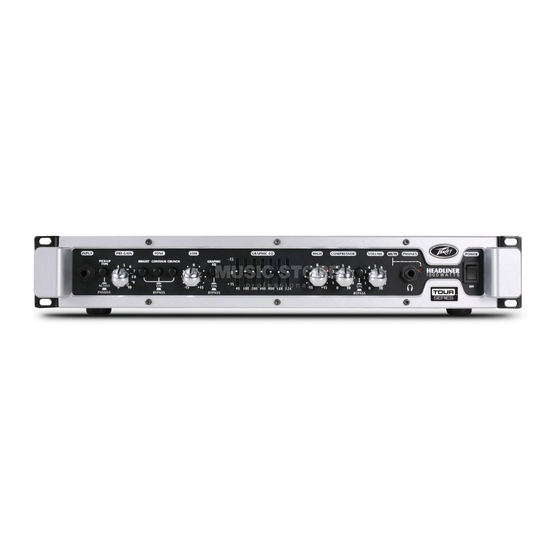
Table of Contents
Advertisement
Quick Links
Advertisement
Table of Contents

Summary of Contents for Peavey Headliner
- Page 1 Tour Series ™ Headliner ™ Bass Amplifier Head Operating Manual ENGLISH ....15 FRANÇAIS .... 20 ESPAÑOL ....24 DEUTSCH ....28 ITALIANO ....32 PORTUGUÊS ..36 中文 ...... 40 日本語 ....44 www.peavey.com...
- Page 2 ATTENTION: Afin de réduire le risque de choc électrique, ne pas enlever le couvercle. Il ne se trouve à l’intérieur aucune pièce pouvant être reparée par l’utilisateur. Confiez I’entretien et la réparation de l’appareil à un réparateur Peavey agréé. AVIS: Dans le but de reduire les risques d’incendie ou de decharge electrique, cet appareil ne doit pas etre expose a la pluie ou a l’humidite et aucun objet rempli de liquide, tel qu’un vase, ne doit etre pose sur celui-ci.
-
Page 3: Important Safety Instructions
IMPORTANT SAFETY INSTRUCTIONS WARNING: When using electrical products, basic cautions should always be followed, including the following: Read these instructions. Keep these instructions. Heed all warnings. Follow all instructions. Do not use this apparatus near water. Clean only with a dry cloth. Do not block any of the ventilation openings. - Page 4 Bright and Contour switches, effects loop, master volume and headphone out. The Compressor and Crunch features are footswitch selectable. The Headliner features a built-in XLR direct interface that players can use to route the signal to the house sound system or recording device, and an active/passive pickup switch that compensates for hot inputs. Peavey's...
- Page 5 Headliner Front Panel INPUT 1/4" Instrument Input. WARNING: Never plug the output of a power amplifier into the input jacks. Damage may occur to both units. ACTIVE/PASSIVE PICKUP SWITCH This switch is included so you can choose the appropriate setting for your instrument. The gain structure of the amplifier is modified to accommodate both active or passive pickup configurations.
- Page 6 The other fault condition is when the output short protection is activated either by a shorted speaker cable or by exceeding the 4 ohm load limit. If the LED stays red all the time, the amplifier needs to be taken to an authorized Peavey service center immediately for service. POWER SWITCH To apply power to the unit, flip the switch to the “ON”...
- Page 7 1/4" powered speaker output, paralleled with 2-pin twist-lock powered output (19). FOOTSWITCH JACK Plug your Headliner footswitch into this 1/4" jack. The footswitch controls the crunch effect and the compressor on/off. NOTE: The crunch and compressor buttons MUST be engaged to operate with the footswitch.
- Page 8 Tour Series Headliner Head Specifications ™ ™ Tour Series Headliner Head NOTE: All specifications tested with Power Output: Input Sensitivity (input selector set to mains voltage maintained at nominal All measurements with no more than passive): level. 1% THD + N Nominal Input = -17.8 dBu...
- Page 9 NOTES:...
- Page 10 NOTES: Features and specifications subject to change without notice. Peavey Electronics Corporation • 5022 Hartley Peavey Drive • Meridian • MS • 39305 (601) 483-5365 • FAX (601) 486-1278 • www.peavey.com • ©2011• EX000129...
- Page 11 What Peavey Will Do We will repair or replace (at Peavey’s discretion) products covered by Warranty at no charge for labor or materials. If the product or component must be shipped to Peavey for Warranty service, the consumer must pay initial shipping charges. If the repairs are covered by Warranty, Peavey will pay the return shipping charges.
- Page 12 U.S. customer warranty registration. Logo referenced in Directive 2002/96/EC Annex IV (OJ(L)37/38,13.02.03 and defined in EN 50419: 2005 The bar is the symbol for marking of new waste and is applied only to equipment manufactured after 13 August 2005...











